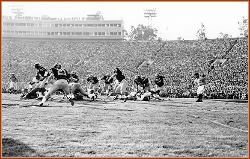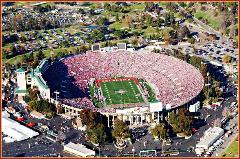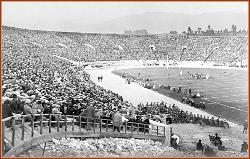



Oregon's Autzen Stadium, consistently ranked among the nation's top 10 venues to watch
a college football game, only got better in 2002.
Beginning its 37th season, the facility which originally was completed for a remarkable
bargain of approximately $2.5 million in 1967, underwent a $90 million facelift that not only
added 12,000 seats and 32 luxury boxes to the stadium's south-side skyline, it improved
the amenities that allows spectators to enjoy a better game-day experience in one of the
loudest collegiate stadiums in the country. The renovation encompassed much-needed
restroom and concession facilities, a 10,000-square foot entertainment center (Club at
Autzen), widened walkway and concourse areas to better accommodate the increased
capacity from 41,698 to 54,000 fans, as well as new ticket distribution centers and guest
services windows to cater to the needs of its patrons.
The result was a record number of fans (450,730) flocking to an athletic arena which has
witnessed more than four million fans walking through the turnstiles to watch Oregon
football since 1987. Further emphasizing its popularity is the fact the Ducks have
exceeded per-game seating capacity on a season basis seven of the last eight years and
enter this season boasting of a school-record 24 consecutive sellouts.
The history of Autzen Stadium is rich. Former Athletic Director Leo Harris was successful
in spearheading the drive to construct a modern and economical football theater to
replace historic Hayward Field. Named in honor of Portland lumberman, sportsman and
philanthropist Thomas J. Autzen, the stadium is situated on a 90-acre site adjacent to the
north bank area of Eugene's Alton Baker Park. The site is north of the Willamette River
and is approximately one-quarter mile north of the main campus, easily accessible by a
scenic footbridge.
Following Oregon's first outright Pacific-10 Conference championship, the athletic
department named the playing surface of Autzen Stadium after its winningest football
coach of all time Rich Brooks in 1995.
Autzen's natural grass playing surface underwent it?s first facelift in 1969 with the
installation of its first artificial turf. The surface was replaced in 1976 and a new covering
of OmniTurf was installed before the 1984 campaign. The field was replaced with a
OmniTurf surface prior to the 1991 season. In 2001, Ducks played on NexTurf before
upgrading its surface to FieldTurf in 2002, which has polyethylene and polypropylene
fibers designed to resist extreme temperature and weather conditions.
The skyline of Autzen Stadium also was first improved in 1981 with the addition of the
Barker Stadium Club behind the east end zone. The facility provided the stadium with
additional meeting space and functional surroundings for pre-game activities prior to
subsequent improvements.
One of the most significant improvements in the history of the athletics department was
completed in time for the start of the 1988 season. The press box along the north rim of
the stadium was relocated to the south side to make room for the $2.3 million three-story
skysuite complex. The project included the construction of 11 individual sky boxes along
with a 460-seat master skysuite, with the revenue generated from the leases serving as
the cornerstone for financing of the construction of the Len Casanova Athletic Center.
A $4 million MegaVision four-color video display scoreboard was added to the skyline in
1998. Measuring 88 feet by 56 feet at its extreme points, the structure almost doubled the
size of the previous scoreboard.
In the first game played at Autzen Stadium, nationally ranked Colorado defeated Oregon,
17-13, on Sept. 23, 1967, before a regional television audience. The program recorded its
initial and only win in the first-year stadium that same season on Oct. 21 vs. Idaho, 31-6.
Since its opening, the Ducks have proceeded to accrue a home-field record 118-82-5
(.588), including a 32-4 ledger from the start of the 1997 season until now. Oregon
established a new stadium record for consecutive victories with its 11th straight triumph
coming by way of a thrilling triple-overtime win over USC in 1999, and extended that streak
to a national-best of 23 wins in a row before Stanford curtailed the second-longest streak
in conference history on Oct. 20, 2001 (49-42).
The program's 14 straight Pac-10 wins during that tenure (1997-01) remains a league
record, surpassing USC's previous conference pinnacle (12, 1986-89).
The Ducks went undefeated at Autzen Stadium for the first time ever with their 7-0 record
in 1990 and since have duplicated the unbeaten feat in 1998, 1999 and 2000.














